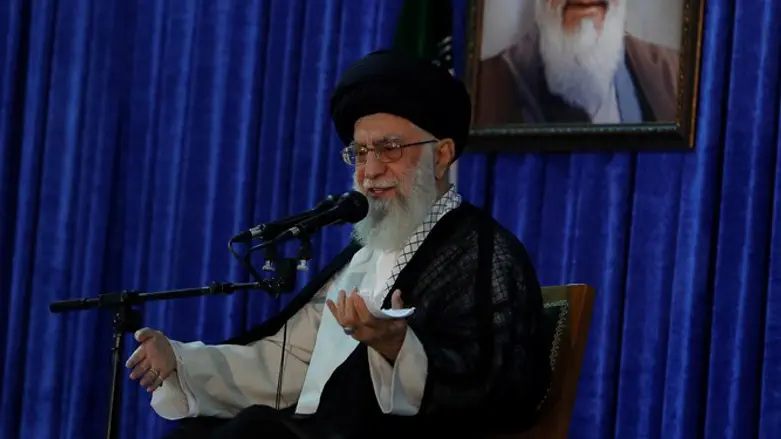
Yochanan Visser is an independent journalist/analyst who worked for many years as Middle East correspondent for Western Journalism.com in Arizona and was a frequent publicist for the main Dutch paper De Volkskrant. He authoreda book in the Dutch language about the cognitive war against Israel and now lives in Gush Etzion. He writes a twice weekly analysis of current issues for Arutz Sheva
At the end of May US Secretary of State Mike Pompeo introduced America’s new Iran policy which centers around the Islamic Republic’s imperialistic agenda for the Middle East.
“Iran will be forced to make a choice: either fight to keep its economy off life support at home or keep squandering precious wealth on fights abroad. It will not have the resources to do both,” Pompeo said ahead of the presentation of 12 basic requirements which were meant to end Iran’s growing dominance in countries such as Syria, Iraq, Lebanon and Yemen.
Pompeo’s presentation came after the reintroduction of a sanction regime against Iran by the U.S. government on May 8, 2018, when President Donald Trump announced the United States would quit the Joint Comprehensive Plan of Action (JCPOA), the 2015 landmark nuclear deal with the Islamic Republic.
Although the Trump Administration officially denies it is striving for regime change in Iran, it has become increasingly clear that strangling the regime of Supreme Leader Ayatollah Khamenei is the real reason for reintroducing biting sanctions on the Islamic Republic.
And the new U.S. strategy is beginning to bear fruit.
This week the Iranian currency rial further lost ground against the dollar with exchange offices offering 150.000 rials or 15,000 tomans to the U.S. dollar.
The rial lost another quarter of its value in just three days, causing fear among the Iranian population.
The Iranian currency has dropped a staggering 140 percent in value since Trump decided to pull out of the JCPOA, while the reported inflation rate stands at 18 percent and is increasing rapidly.
Experts believe the actual inflation rate is much higher and could be multiples of that number.
Forbes, furthermore, reported on Sunday that a $12,000 ceiling on the amount of foreign currency that Iranian citizens can hold outside banks “prevents ordinary people from protecting themselves from the loss in value of the Rial.”
The fact that regime officials are still able to buy dollars below the unofficial market rates has further fueled anger among the Iranian population, which feels cheated and demands change.
Initially, the Iranian Central Bank announced it would punish exchange offices trading dollars above the official rate of 42,000 rials to the dollar but was forced to drop the measure after panic broke out among the Iranian public.
Economic experts now predict that the Iranian economy will slide into recession and that the Gross Domestic Product will contract by 3.7 percent in 2019, It had hit a double digit growth rate in the years after the implementation of the JCPOA which filled the coffers of the regime with a staggering $150 billion.
Almost all of this money has been spent on expanding the Islamic Revolution in the Middle East and on a sharp increase to the budget of the Iranian Revolutionary Guards Corps (IRGC).
The unemployment rate in Iran currently stands at 40 percent, Breitbart reported Wednesday, while the currency crisis has caused a sharp increase in food prices and other basics such as diapers.
The economic crisis is expected to worsen in November when the U.S. plans to introduce new sanctions aimed at Iran’s petrochemical industry.
Oil exports from Iran have already decreased by 600,000 barrels a day between July and August, according to the Oil Price website which claimed the forthcoming sanctions will affect every link in the oil supply chain of the country.
Ayatollah Khamenei now openly admits that the Islamic Republic is in deep trouble financially, and blamed the U.S. for the economic meltdown.
The Iranian dictator called the reintroduction of sanctions “economic sabotage” and suggested that the Trump Administration is working to fuel anger among the Iranian population.
“The enemy wants people to be angry with the government and system. This is one of their ways,” Khamenei said last weekend according to his official website.
The Iranian people, however, don’t buy Khamenei’s attempts to blame the crisis on the United States.
Protests against the Islamist regime continued unabated in August and involved 27 cities in 13 provinces in Iran, according to the regime-controlled news agency IRNA.
An estimated 1,000 people were arrested by plainclothes agents belonging to the Bassij militia of the IRGC.
Most of them had been arrested during earlier protests and were members of the Mujahedin e-Khalq (MEK), a resistance movement founded in 1965 long before the Islamic Revolution of 1979.
The IRGC says the “Zionist regime” together with the U.S. and Saudi Arabia are secretly assisting MEK in organizing the uprising against the regime, while “alien media” are designing the slogans chanted during demonstrations.
The Iranian regime has now turned to the International Court of Justice in The Hague, Netherlands accusing the U.S. of “economic strangulation” and demands the United Nations body suspend the American sanctions.
The Islamic Republic claims that Trump’s decision to re-impose the sanctions constitutes a breach of a 1955 treaty between Iran and the United States.
Trump, meanwhile, said that future of the Islamist regime in Tehran is in doubt.
After his meeting with Kuwait’s emir, Sheikh Sabah Al-Ahmed Al-Sabah, the President told reporters “Iran is in total turmoil”.
“Now they are just worrying about their own survival as a country,” Trump claimed, adding “when I came into here, it was a question of when would they take over the Middle East. Now it’s a question of will they survive. It’s a big difference in one and a half years.”